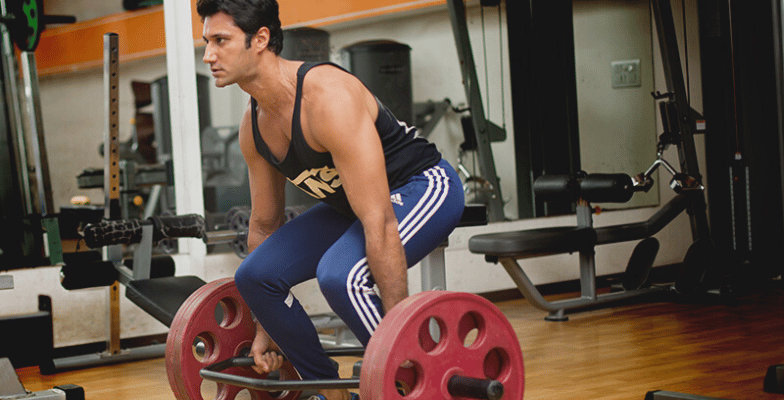Trap Bar Deadlift: The Definitive Guide
- The History Of Deadlifts
- Difference Between Conventional & Trap-Bar Deadlift
- Why Trap Bar Deadlifts Over Squats?
- How To Perform A Trap Bar Deadlift
- Conclusion

I try to be highly selective in what I spend my time on, and that includes the exercises I do in the gym. If you recall, the first law of Fabulous Body states that the 80/20 rule applies to everything you do.
Now, if you apply this rule to your training, 20 percent of all exercises you do, will give you 80 percent of the results. Compounded, this means that only 4 percent of exercises produce more than 64 percent of results! Think about this for a while.
What are these 4 percent of exercises? You guessed it right, Squats & Deadlifts!
Now, when we talk about deadlifts, we mean simply the movement of picking up weights from a dead stop. It’s as primal and functional as movement can get. Deadlift is a multi-joint strength exercise that not only works your hips, but also your back, quadriceps, hamstrings, and abdominals.
About two thirds of your total body mass is in your thighs, buttocks, and back. The rest of your musculature- shoulders, chest, arms, forearms, and calves is the remaining third. Did you know that thigh/hip/back work through functional multi-joint movements like deadlifts and squats yields substantial growth in the fastest time possible?
Further, these compound movements work your stabilizing muscles, and the effect carries over to your real life as well. You become more functional overall as compared to when you build your strength on machines or do isolated movements.
Deadlift has been called the ultimate test of strength, and in fact, it’s one of the three movements, besides bench press and squats, that is associated with powerlifting.
The History Of Deadlifts
In the early 20th century, Hermann Goerner was the strongman who brought the deadlift movement into the limelight. Although he was not a household name like Eugen Sandow, his feats of strength will blow you away:
Deadlift – 360 kg (790 pounds) with overhand hook grip
Deadlift – 270 kg (600 pounds) using just two fingers of each hand
Clean and press – 177.5kg (391 pounds)
Leg pressing 24 men, total weight 1,870 kg (4,120 pounds), on a plank with the soles of his feet
Further, Goerner was known for his odd acts of strength, such as wrestling an elephant and juggling 50 kg kettle balls among others.
Well, I believe none of us is interested in building the super-human strength to wrestle with the elephants!
Instead, I am sure most of us simply want to build lean muscles, drop body fat, and get as functional as possible.
This is achievable by doing compound movements like squat and deadlift (and a few others) and getting stronger in them over a moderate rep range (5 – 10).
Please note that anything below five reps will build more of a performance strength. This type of strength is based on neural factors and is mainly used by powerlifters whose main goal is not the size but simply pure brute strength.
Conventional deadlift is usually a complementary movement to squat, as the former is a hip dominant movement while the latter is a quad dominant one.
However, this is not the case with trap bar deadlifts, as we will find out in the next section.
Difference Between Conventional & Trap-Bar Deadlift
1) Conventional deadlift is performed using a straight Olympic bar, whereas trap bar deadlift is performed using a trap, or better, a shrug bar.
Al Gerard, a powerlifter, developed the rhombus-shaped trap bar, which enabled him to deadlift without the back problems he experienced with the straight bar deadlift. 1https://en.wikipedia.org/wiki/Trap_bar
In recent years, shrug bars have been more popular, as they have more space inside them. A shrug bar is also called a hexagonal bar, as it’s shaped like a hexagon.
2) Another difference between the trap bar and the conventional deadlift is that with the former, the center of gravity of the resistance is in close alignment with the center of gravity of the lifter.
This enables the lifter to remain more upright and takes stress off the lower back, making trap bar deadlift a quad dominant movement as opposed to a hip dominant one.
3) With conventional deadlift, I have witnessed many trainees with bruises, and in some cases bleeding, as the bar is lifted.
However, with trap bar deadlift, since the weight is held next to your body instead of out in front of it, your shins are spared!
4) Trap bar deadlift works more musculature than its conventional counterpart, as there is more knee flexion, which then results in more muscle growth over time.
Also, since there is reduced spine stress, the trainee is able to recover sooner. I can easily fit in around six sessions of this awesome compound movement in a month. However, with conventional deadlifts, I always needed more time in between workouts to recover.
Bret Contreras, a renowned expert on strength and conditioning, mentioned in one of his blog posts that if he could perform/prescribe only ‘one’ exercise, his choice would be the trap bar deadlift! 2https://bretcontreras.com/if-you-could-only-do-one-lift/
According to Contreras, this exercise does more than any other for building total body muscle and creating favorable adaptations for increased athletic capacity.
Why Trap Bar Deadlifts Over Squats?
Let’s discuss why you should choose trap bar deadlifts over squats as your main exercise if you have long limbs in relation to your torso.
According to Stuart McRobert, renowned author of Brawn and Beyond Brawn:
Many bodybuilders legitimately can’t barbell squat well and particularly can’t squat low enough safely. This is due to structural issues.
A person with, proportionately speaking, long thighbones and shinbones but a short torso is always going to struggle in the squat, and perhaps to such degree that they can never obtain substantial benefit from the exercise.
Such bodybuilders need an alternative to the barbell squat. But leg extensions won’t cut it, and though leg press is much more effective than the leg extension, it’s not good enough to substitute for the barbell squat.
McRobert further adds,
If your leverage is favorable to trap bar deadlift, this exercise will work your thighs more than the barbell squat even though it’s not necessary to descend in the trap bar deadlift until the top of your upper thighs is parallel to the floor in order to mimic the same effect on the thighs from barbell squatting to parallel.
Consider this experiment by John W. Chow and Mark D. Tillman, et. al., 3http://www.asbweb.org/conferences/2003/pdfs/93.pdf where it was hypothesized that reduced EMG levels in lower back muscles would be observed in the trap bar while no differences in thigh muscle activity would be found between barbell squat and trap bar squat:
Twelve males and four females with mixed strength training experience were asked to perform two trials of three repetitions of squat and parallel grip squat using the trap bar. Muscle activity was detected using a MESPEC 4000 radio telemetry EMG unit.
Results were in accordance with the hypotheses, that is, reduced EMG levels in lower back muscles was observed in the trap bar while no significant differences in thigh muscle activity was found between bar types.
The exercise can also be called parallel grip squat (as used in the study above), as almost the same musculature gets worked as in the barbell squat.
If we further discuss why a person should choose a trap bar deadlift over a squat, Stuart McRobert lists five big advantages:
1) The resistance is held beneath the body rather than precariously near the top of the spine, and thus there’s no bar bearing down on you.
2) Good form may be easier to maintain because the parallel grip deadlift is technically less demanding than the barbell squat.
3) Spotters aren’t needed.
4) No squat stands, power racks, or safety bars are needed.
5) The exercise is easily done from a dead stop at the bottom.
Stuart also clarifies that everything considered and generally speaking, the trap bar deadlift carries a lower level of risk than the squat, but that isn’t to say the trap bar deadlift is safe and the squat isn’t.
It’s easy to injure oneself in the trap bar deadlift if one doesn’t use good form.
In my FBX training system, I advise performing squats and/or trap bar deadlifts two times a week, preferably on Monday and Friday or Tuesday and Saturday. The idea is to leave a gap of at least 72 hours in between sessions to allow your lower back to fully recover.
Since I have long limbs in relation to my torso, I find trap bar deadlift more suitable than squat.
After having consistently performed trap bar deadlift for over two years, I feel my thighs have become the strongest part of my body, and I never felt the need to include leg press or any other additional sets of lower body exercises other than a few sets of this wonderful exercise each week.
Key note: If you are more structurally suited for squats, that is, if you have legs and thighs of average or shorter than average length relative to your height, I would still highly recommend including trap bar deadlift in your workouts for a few months each year.
Having said that, I still love squats and do perform them from time to time for few months in a year.
How To Perform A Trap Bar Deadlift
1) Make Sure You Warm Up Properly
If you are doing trap bar deadlift first in your workout, perform a general warm-up on a cardio machine for five to ten minutes or until you break into a light sweat. Then, perform a few specific warm-up sets by gradually increasing the weights.
2) Trap Bar Deadlift Stance
Once inside the bar, keep your feet slightly wider than shoulder-width apart and your toes pointing 30 degrees outwards. I feel really strong in this position, and over time, I have found that this width works pretty well for me.
Fine tune this, a little wider, or a little closer to suit you. Note that a shrug bar will be roomier than a trap bar, which will give you more stance options.
3) Performing The Trap Bar Deadlift
Once you have the correct stance, bend over and take the centered parallel grip, stick your chest out, retract your shoulders, and bend your knees. Look forward, take a deep breath, and stand up while holding the bar.
Extend both your knees and your back at the same time. If you extend your knees too quickly, you will put more stress on your back. If your bend your knees too much, you will put too much stress on them.
The idea with trap bar deadlift is to balance both knee and back involvement and work them as a unit. The descent should be controlled, maintaining a slight arc when lowering the weight down. (Don’t round your back while lowering the weight.)
Once you are done with your first rep, don’t rush for the second one. Trap bar deadlift is done from a dead-start! Take a breath again, and repeat the steps for the desired number of reps.
4) Ideal Range Of Motion
The ideal range of motion will be with a 20 kg (45 pound) plate on each side. If you are a beginner and cannot handle this starting weight, use a lighter plate with a similar diameter to the 20 kg plates.
5) Breathing
This is the key. Instead of inhaling during the ascent, I recommend taking a deep breath before you start the rep. This increases intra-abdominal pressure, which keeps your core safe.
Complete the entire rep in a single breathe, and use one breathe for each subsequent rep.
Conclusion
I have literally worked out in many gyms around the world, and you guessed it right, trap bars are nowhere to be found. The reason is probably because no one wants to promote this awesome exercise, as there are no profits to be made from do so.
A trap/shrug bar is an inexpensive piece of equipment, and if the trainee acknowledges the massive benefits that can accrue from using it, he/she will probably not use or buy (or will minimize the use of) other expensive pieces of strength and cardio machinery.
This one piece of equipment can revolutionize your life, as it has mine. It has the potential to turn weaklings into superhuman.
Further, I strongly believe that trap bar deadlift has the potential to snatch the title ‘King of Exercises’ from squats, especially for people who are structurally suited for it (those with long limbs in relation to their torso).
What do you think about trap bar deadlifts? Have any questions you’d like to ask? Let me know in the comments below!

Skill-Based Education.
Global Recognition.
Powerful Community Building
Secure a certificate of completion in as little as a day by graduating from one of our free courses.
Get Access to Our Free Courses. No Credit Card Required.

Fabulous Body Membership
Your All-Access Pass to A Fabulous Body & A Rewarding Career
25+ Certificate Courses & Programs, All Included
15 Day Free Trial, 100% Money-Back Guarantee
About Akash Sehrawat
Akash is a creator of 25+ programs and certificate courses in which more than 200,000 students have enrolled both on Udemy and Fabulous Body's native platform. Akash is also an author of three books that can be found on Amazon. His answers on Quora have gathered more than 12 million views in less than a year.











I know this is an old post, but I had to comment. What a great article on the trap bar. Due to some limitations with the barbell squat, I love that I can still get the same (or near same) range of motion and biomechanics of a squat without having to load a heavy barbell on my back. I have been doing exclusively trap bar deadlifts for leg training since I had shortcomings with the squat. My squat was nothing to sneeze at either: Full range of motion 315# x 10 reps. Since I stopped squatting, I have kept all the size in my thighs and even increased it a little since I have gained about 10#. Huge legs is not my goal either so I don’t feel I need to do barbell squats anyways. People shouldn’t knock the trap bar and should give it a try. I couldn’t fit a squat rack in my house, but can use a trap bar just fine and still get a great leg workout.
Hello Steven,
Thanks for your comment. Only if trap bar was as common as a barbell millions around the world (especially ectomorphs-long limbs in relation to their torso’s) would build muscle much faster.
Hello John, Yes trap bar is amazing. It’s unfortunate that’s it’s not widely available in gyms in the United States let alone in the rest of the world. I strongly believe its a great substitute for squats (especially for tall people who have longer limbs as compared to their torso’s). Thanks for sharing your example, it re-instates just how important this movement is.